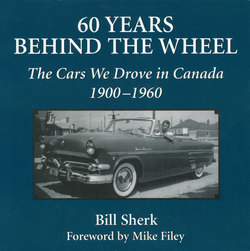Читать книгу 60 Years Behind the Wheel - Bill Sherk - Страница 21
На сайте Литреса книга снята с продажи.
ОглавлениеTwo-car Garage, Leamington, 1912
THE TWO-CAR FAMILY BECAME widely popular in the 1950s, thanks to the rising tide of prosperity that followed the end of the Second World War. Back in 1911, William T. Gregory built a two-car garage that still stands at 43 Mill Street West in Leamington, Ontario. The building to the right was his office, used until recently by his nephew, the late Herbert T. Gregory.
In an interview shortly before his death, Herb Gregory recalled his family owning an Autocar (not the car in the photo), which was garaged in this building. It was tan in colour and built by the Autocar Company of Ardmore, Pennsylvania. Inside the garage was a large green container of bulk oil with a crank to pump it out. “I used to love turning that crank as a boy,” he said.
Another make of car Herb recalled was the Hupmobile. His dad and uncle prospered as agents of the Imperial Tobacco Company, with an office in Leamington. The company purchased a fleet of four or five Hupmobile roadsters around 1911 for their tobacco agents to visit farmers. Herb said, “They were little two-seater cars with chain drive and a canvas top. I remember them well.”
The large touring car parked in front of William T. Gregory’s garage is difficult to identify because of the angle of the photo. Glenn Baechler, co-author of Cars of Canada, reports, “ I really exhausted all the candles on this one as it really is a great picture. [The car] has all the features of a Buick but from this view it appears like a longer wheel base. I think it is either a Westcott or a Kissel.”
Although the car carries a 1912 Ontario plate, it can’t be a 1912 Cadillac. That’s the year Cadillac introduced its legendary electric starter, along with electric headlights and cowl lights. The car in the photo has the more primitive acetylene lights.
The car has right-hand-drive, as did most early cars, so the driver could keep a close eye on the ditch while struggling to keep the vehicle on the road. The absence of a rear bumper was the norm in 1912, although many makes offered them as an option. The tool box on the running board was a vital necessity. The spare tire (sometimes two) is presumably mounted on the far side of this car. The identity of the two men is unknown.
The front wheels have ten wooden spokes, while the rear wheels have twelve, no doubt a reflection of the muddy roads and rear-wheel-drive. The extra strain of ploughing through the mud is better spread across twelve spokes than ten.
As a car aged, the wooden spokes would dry out and shrink, causing the wheels to wobble. You then parked your car up to the hubs in a nearby river. The dry spokes would swell up and tighten the wheels, making them as good as new.
